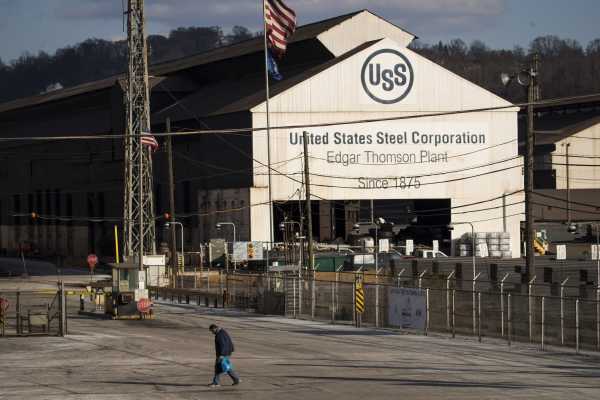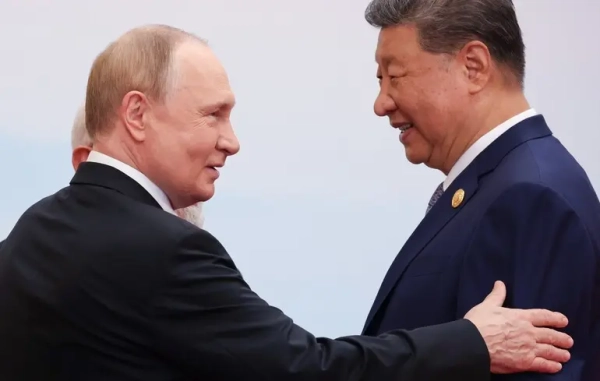
For Dan DiMicco, the former steel executive and trade adviser to Trump who reportedly nearly became United States trade representative, there’s no risk of the president’s recently announced tariffs sparking a trade war — we’ve already been in one for years.
The only difference now, he said, is that we’re deciding to fight back. “Don’t tell me about starting a trade war,” he said. “The Chinese have been perpetrating a trade war on us since 1995.”
President Donald Trump’s proposal to impose a 25 percent tariff on steel imports and 10 percent tariff on imports of aluminum has been met with opposition from the business community, global economies, and lawmakers on the left and, even more so, the right. But DiMicco is among those who thinks they’re putting the US back on the right track.
I spoke with DiMicco, the former chair and CEO of steel company Nucor who has spent most of his career in steel and manufacturing, about the case for President Trump’s tariffs, which so many others have maligned. DiMicco served as a senior trade and economic adviser on Trump’s 2016 presidential campaign and led the US trade representative transition team.
The president reportedly bypassed him for the trade representative job, which ultimately went to Robert Lighthizer, but DiMicco remains in the White House’s orbit. The president in December named him to the Advisory Committee for Trade Policy and Negotiations, and he is in contact with Lighthizer and Commerce Secretary Wilbur Ross. (He says he does not speak regularly with Trump.)
DiMicco, much like the president, has been for years advocating for a trade crackdown and is especially vocal about China. He laid out the argument for Trump’s latest trade aggressions and said those who are worried about their ramifications are missing the point. “We’ve been in a trade war for 30 years,” he said. “We were under attack; US manufacturing has reached a critical stage from 2000 to today because of what China’s done.”
This interview has been edited and condensed for clarity.
Emily Stewart
So, setting out, you advised the Trump campaign on trade and headed the US trade representative’s transition team. You think these tariffs are a good idea. What’s the case for the tariffs, and more specifically, what’s the case for them as a national security measure?
Dan DiMicco
The case is national defense, national security, and that’s a significant part of the 232. [The Trump administration has invoked section 232 of the US Trade Expansion Act of 1962 in its tariff proposal; the act states that if the US doesn’t have reliable access to materials required for national security, the country has license to set up big trade barriers in order to boost domestic production of them.]
The way that it impacts national security is that during the campaign and the transition, we worked on getting the message out that there is no national security if you don’t have economic security, and there is no national security if you lose your basic manufacturing industries. You can’t remain a world leader and be a shining light for the world to deal with whatever adversaries need to be dealt with if you don’t have a strong national defense, which is promoted by strong economic security.
The steel industry is an example, and the aluminum industry, they are very capital-intensive industries. They have to be able to earn well in excess of their cost of capital, probably a multiple or more over the business cycle in order for them to be able to do the massive reinvestment they need to modernize, take on new technologies, expand, and take care of their customers’ requirements.
Over the last nine years, the cost of capital to the industry — and it varies dependent upon the players — has probably been somewhere around 10 to 12 percent. The return on invested capital, which you need to have to exceed the cost of capital so you can reinvest, thrive, and be around for 10, 20, 30 years, was close to zero or negative during that entire period. Even the best steel companies in this country, whose cost of capital could be closer to nine or 10 percent, earned a fraction of the cost of capital, somewhere around 40 to 50 of it. You can’t sustain an industry when you are having that kind of performance based upon whatever the factors are.
In this case, the manufacturers are not lacking productivity, because the steel industry is one of the most efficient in the United States and one of the most efficient in the world, the most productive in the world — Nucor in particular, but also others, like Steel Dynamics and US Steel and AK Steel. They’ve all improved their productivity over the past several years, somewhere around 5.5 percent.
So it’s an issue of steel coming in, the global overcapacity created by China, and the destruction it’s creating in our basic industries. In this case, the 232 is focusing on aluminum and steel. But as you should know, the administration and, in particular, Wilbur [Ross] talked about the fact that there are probably going to be seven to nine industries they’re going to look to investigate to see if 232 action is appropriate, things like semiconductors, aerospace, and other things are being looked at and will be looked at.
There’s going to be a 301 filing on intellectual property theft by the Chinese. [Section 301 of the US Trade Act of 1974 allows the president to impose import tariffs to sanction unfair trade practices.]
The case for this is much broader. It’s a major part of Trump’s trade reform agenda, which is part of his four-point economic strategy: tax reform, trade reform, regulatory reform, and energy reform. The case is that you’ve got to stop the trade cheating in order to have an industry that can earn its cost of capital in excess of it so that it can reinvest it here when we need that. And it’s not just for tanks and ships and rail cars, things associated with the military.
You’ve got to have a strong infrastructure to support the military effort at ports and railyards and in trucking and roadways. And so the industry has a national defense and national security impact greater than people have alluded to, those people who are saying the sky is going to fall.
Emily Stewart
So you bring up China, but China isn’t where we get most of our steel from, we get a lot more from Canada, Brazil, Europe.
Dan DiMicco
That’s a misconception. The global steel excess capacity is related to one country — China, China, China. Because somebody says we only get 2 percent of our steel from China doesn’t mean that China is not having a significantly greater, 10 times greater, impact on the steel situation in this country and other countries around the world, not just the United States.
Let me give you examples. First off, the Chinese have become very adept at transshipping and circumventing so that the products come in mismarked, misidentified. They’re steel, but they come in mislabeled, they come in through surrogate countries like Vietnam and South Korea. They come in the form of the steel that the steel mills make, and they also come in the form of steel products. The impact is much greater than the 2 percent indicated.
In addition, the overcapacity is felt in this country because there’s all this excess capacity. It doesn’t all have to come directly here to have a major negative impact. If China sends steel to South Korea or to Brazil or the European Union with that excess capacity, then the folks that were supplying those customers in Korea and the EU and in South America, they have to find a home for their steel, so they start looking around for the most open market in the world, and guess who it is? It’s the United States.
So then we start seeing countries being forced to push their exports into our market because of what China’s doing globally. They do the same things globally that they do here, they circumvent, they transship. They’ve got the game down, they put stuff in containers and mismark them. Our customs people are getting much better at catching this stuff, but they have limited resources, and they’ve got to be increased.
The 2 percent number is fake news, it’s not representative of the true impact. It’s millions of tons more coming directly from China or because of the effect of China ton other countries to move their steel products to their customers.
Here’s living proof: [On Tuesday], there was an announcement that Eurofer, the European Steel Association, made a demand of the EU that they put quotas on all countries sending steel into the EU because they fear that the steel that was coming here is now going to be forced to come into their market, which is exactly the reverse of what’s been happening to us. [Eurofer president Geert Van Poelvoorde at a press conference on Tuesday called for a focus on steel overcapacity instead instead of the US deploying steel tariffs and warned that American tariffs could cause increased steel imports to Europe because of trade deflection.]
Eurofer and the EU are making our case for us about global overcapacity and the implications of what China does to force countries to ship their products other places as well. The EU isn’t just concerned about China but also the circumvention and the effects of other countries having to move their products other places because they can’t compete with China where they were sending their product before.
That [2 percent] number everybody quotes is basically a number that people have manipulated to exaggerate a situation that doesn’t exist. China is the culprit, and the rest of the world in their action or lack of action is complacent and enabling China in its overcapacity.
Emily Stewart
Okay, so these tariffs are meant to benefit American steel and aluminum producers, but what about companies that use a lot of steel and aluminum, like car manufacturers, and those workers?
Dan DiMicco
Good question, and another one of those Chicken Little, the sky is falling things. Not that there’s not going to be some impact, but it will be relatively small.
Now let me explain why I say that. In 2002, we had a thing from the Bush administration called a 201 tariff. [Bush used Section 201 of the Trade Expansion Act, which allows the president to investigate whether an industry needs safeguard protections from imports, to impose tariffs of 8 to 30 percent on imported steel. The tariffs took effect in March 2002 and were lifted in December 2003.] It was applied to all countries. It was 30 percent. There were all kinds of claims made about how it was going to end the world.
The International Trade Commission conducted a study after the 201 was removed, which was done 18 months after it was put in place. The study came out conclusively and said two main things. One, there were no net job losses in the United States because of the 201. Two, the GDP saw no impact — no impact means essentially no impact, it may have been .0001 percent. But those are the two major findings on a tariff that was 15 percent greater than what we’ve got.
History teaches us, recent history, that this Chicken Little analysis that’s out there by the folks opposing this is way overexaggerated.
I think you’ve seen on Tuesday where [Canadian Prime Minister Justin Trudeau] has come out and started to attack China for their global overcapacity. That is in part due to the fact that our government is saying, “Listen, you all need to stop talking about doing something about China’s overcapacity, and you need to start doing something, and if you don’t want us to be hitting you with 25 percent tariffs, you have to join our fight, and you have to make sure you don’t allow circumvention and trans-shipment through our country in our market.”
What Trump is doing with our allies is getting them to finally stop talking about doing something and do something. For 15 years, the OECD and the global steel industry has put warnings out and said, “Hey, this has got to stop.” But nothing ever gets done — the Chinese make promises, and they don’t do anything. They just keep getting more and more and more capacity. President Trump’s just saying enough is enough.
This is just part of his overall strategy on trade reform. It’s the beginning, you saw it with the aluminum tariffs and the solar panel tariffs, the 201 on solar panels. You already see that the companies that were negatively impacted are going to grow and expand again in this country. Because of the support by the president of steel and aluminum, Century Aluminum is restarting and expanding its operations, spending well over $100 million.
Granite City’s US Steel operation is being restarted. Nucor is building three new steel mills, one in Florida, one in Kansas City, and one in Illinois. [That’s] based upon the fact of this action of the president, which is not time-limited — he has told people straight out there are no limits on how long this is going to last. These are going to be around as long as necessary.
Emily Stewart
So on the Bush tariffs, there are varying studies out there that say different things, that on net more jobs were lost, or that there wasn’t a significant amount of jobs lost or gained. How do you explain that?
Dan DiMicco
That’s wrong. Go to the ITC study, it’s very clearly stated on what the case is.
There was originally a report that came out from a consuming industry trade group called CITAC [the Consuming Industries Trade Action Coalition]. CITAC reported that there were over 220,000 job losses because of the tariffs. That was later completely debunked by many of their own peers, let alone by the ITC and the US steel industry, because the time period that they chose to look at job losses was the time period prior to the tariffs coming into place.
That’s why the tariffs were put in place to begin with, because of the massive job losses, 38 steel companies going bankrupt and tens of thousands of workers being put off, and the multiplier effect to the negative of four or five times in the industries that supported those steel operations. That was phony news, that was fake news, and their own peers called them out on that.
Emily Stewart
So let’s say, okay, these tariffs in and of themselves aren’t going to be a big deal to the economy, they’re not going to add or wipe out a lot of jobs on net. But what about the risk of a trade war? What if we do this, and Europe retaliates, and it escalates?
Dan DiMicco
We’ve been in a trade war for 30 years. We were under attack, US manufacturing has reached a critical stage from 2000 and today because of what China’s done. So, my answer to that is don’t tell me about starting a trade war, the Chinese have been perpetrating a trade war on us since 1995 when they reevaluated their currency and dropped it by 80 percent to gain a major currency advantage in devaluing their currency to promote their own domestic growth and own domestic manufacturing growth.
Then they said the steel industry is going to be strategic, we need it to be a world power, so they made it strategic and 95 percent of it’s state-owned, and they built 900 million tons of capacity when they had only about 100 to 150 million tons before they started that. They get that the steel industry is strategic to their economic strength and to their national defense and their ability in world. Why the hell is it so damn hard for people here to get the same message that are fighting us on this? It’s because they have ulterior motives, and we’ll call the out on that, call a spade a spade.
We are in a trade war. We have not engaged, we have not engaged in the Bush administrations, we have not engaged in the Clinton administration, we have not engaged in the Obama administrations. The last president in this country to engage and to fight against the trade war against us was Ronald Reagan when it was being perpetrated by the Japanese and the Germans in the 1980s.
We today have a president who gets it, it’s part of his basic makeup. He’s been arguing these points since the late ’70s, early ’80s. This is not something that’s new to him, it is something that is part of his core beliefs. He is going to deliver on his promise to have massive trade reform and make sure that we actually live in a world where free and fair trade is the dominant form of trade, not trade mercantilism and predatory pricing.
We are in a trade war. President Trump is just engaging now, saying enough’s enough.
Sourse: vox.com






